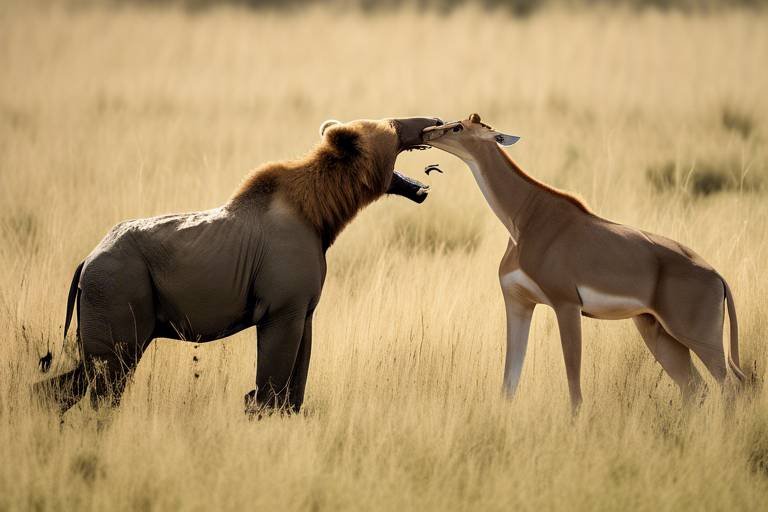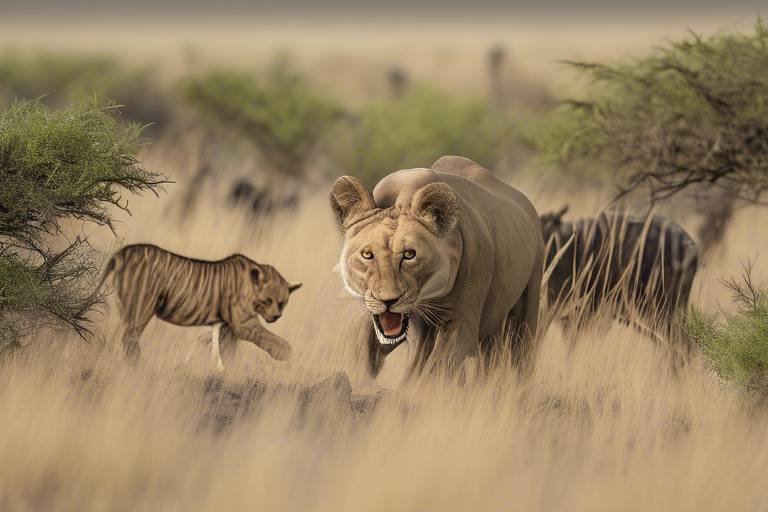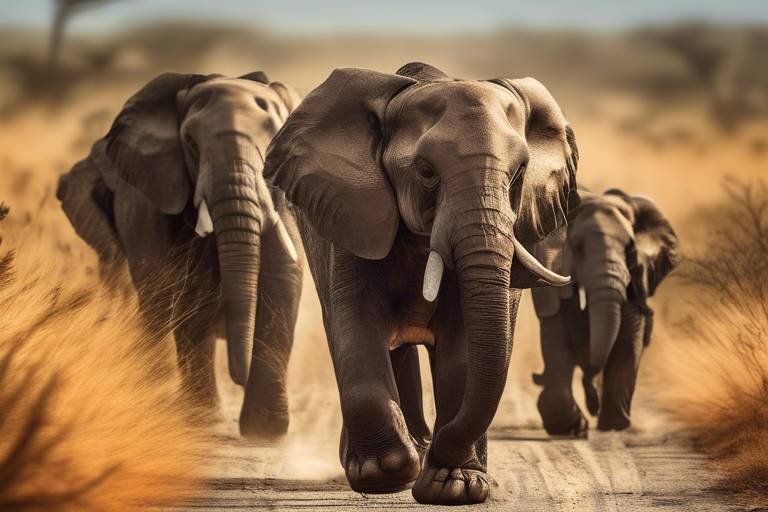Coexisting with Wildlife: Reducing Conflicts and Building Harmony
In an increasingly urbanized world, the call for harmony between humans and wildlife has never been more urgent. As we expand our cities and alter natural landscapes, we often find ourselves at odds with the very creatures that share our environment. The reality is that wildlife is not just an abstract concept; it is a vibrant part of our ecosystems that contributes to the health of our planet. So, how can we coexist peacefully with these diverse inhabitants? The answer lies in understanding, respect, and proactive strategies that embrace the beauty of nature while minimizing conflict.
Human-wildlife conflicts occur when animals venture into human-dominated areas, often in search of food, shelter, or territory. These interactions can lead to negative consequences for both parties, such as property damage, injury, or even loss of life for animals. But what drives these conflicts? Factors such as habitat loss, urban expansion, and climate change play significant roles in pushing wildlife closer to human populations. By examining these causes, we can better understand the implications of these encounters and the pressing need for effective management strategies. It’s crucial to recognize that these conflicts are not merely nuisances; they reflect a deeper disconnect between our lifestyles and the natural world.
Coexisting with wildlife is not just about avoiding conflict; it offers a plethora of benefits that enhance our quality of life. For instance, healthy wildlife populations are vital for maintaining ecological balance and promoting biodiversity. When we allow wildlife to thrive, we support natural processes that benefit us all. Think of it this way: just as a well-tuned orchestra creates beautiful music, a balanced ecosystem produces harmony that sustains both human and wildlife communities. This section explores how embracing wildlife can lead to improved ecosystem services and overall well-being.
Maintaining ecological balance is crucial for sustaining healthy environments. Wildlife plays an essential role in processes such as nutrient cycling, pollination, and pest control. For example, birds and bats contribute significantly to pest management, reducing the need for chemical pesticides in agriculture. This not only protects our food supply but also promotes a healthier environment for both wildlife and humans. When we understand the interconnectedness of these systems, we begin to appreciate the invaluable contributions of wildlife to our everyday lives.
One of the most significant contributions of wildlife, particularly pollinators like bees and butterflies, is their role in agriculture. Did you know that approximately 75% of the world's food crops depend on pollination? This highlights the importance of maintaining healthy pollinator populations. Farmers who recognize the value of these creatures often implement practices that support their habitats, leading to better yields and economic stability. Protecting pollinators is not just an environmental concern; it’s an economic imperative that can have far-reaching effects on food production and farmer livelihoods.
Many wildlife species help control pest populations naturally. For instance, owls and hawks can keep rodent populations in check, while certain insects manage pests that threaten crops. By encouraging the presence of these beneficial species, we can reduce our reliance on harmful chemicals, promoting a healthier environment for all. Imagine a world where farmers can harvest bountiful crops without the fear of pesticide exposure—this is the future we can work towards by fostering coexistence with wildlife.
Community involvement is essential for fostering coexistence with wildlife. Education and outreach programs can inform residents about wildlife behavior, helping them understand how to prevent conflicts before they arise. For example, knowing that raccoons are nocturnal and often rummage through trash can encourage people to secure their garbage properly. Engaging with local communities through workshops and informational sessions creates a sense of shared responsibility and empowers individuals to take action. When people feel connected to their environment, they are more likely to advocate for wildlife-friendly practices.
Implementing effective strategies to mitigate human-wildlife conflicts is crucial. Various approaches can help reduce encounters, ensuring safety for both humans and wildlife. These strategies range from habitat modification to community-based initiatives aimed at fostering coexistence. By taking proactive steps, we can create a safer environment for all living beings.
Altering human environments can minimize wildlife encounters. For example, installing wildlife corridors can help animals navigate urban landscapes safely, reducing the likelihood of dangerous interactions. Additionally, creating buffer zones around human dwellings can provide wildlife with safe habitats away from populated areas. These practical habitat modification techniques can significantly reduce conflicts and promote a harmonious relationship between humans and wildlife.
Utilizing deterrents can effectively reduce wildlife intrusions into human spaces. Various methods, such as fencing, noise devices, and scent repellents, can keep wildlife at a safe distance from human activities. For instance, using motion-activated lights can deter nocturnal animals from entering yards, while natural repellents can discourage animals from approaching gardens. By employing these strategies, we can protect our homes while allowing wildlife to thrive in their natural habitats.
- What are common human-wildlife conflicts? Common conflicts include property damage from animals searching for food, such as raccoons raiding trash cans or deer eating gardens.
- How can I prevent wildlife from entering my property? Secure trash bins, use fences, and remove food sources from your yard to discourage wildlife from visiting.
- Why is it important to coexist with wildlife? Coexisting with wildlife supports biodiversity, maintains ecological balance, and provides essential services like pollination and pest control.
- What should I do if I encounter a wild animal? Stay calm, keep your distance, and do not approach the animal. If necessary, contact local wildlife authorities for assistance.

Understanding Human-Wildlife Conflicts
Human-wildlife conflicts are a growing concern in today's world, especially as urban areas expand into once-wild habitats. These conflicts occur when wildlife encroaches on human settlements or activities, leading to various negative interactions. Imagine a bear rummaging through your garbage or a deer munching on your garden – these scenarios are becoming more common as animals search for food and shelter in human-dominated landscapes. The reasons behind these conflicts are multifaceted and often stem from habitat loss, food scarcity, and climate change.
One of the primary causes of human-wildlife conflicts is habitat destruction. As we pave over forests and wetlands for housing, roads, and agriculture, we push wildlife into smaller and often more dangerous areas. This not only increases the chances of encounters but also disrupts the animals' natural behaviors. For instance, a fox searching for food may venture into a suburban neighborhood, leading to potential conflicts with pets or livestock.
Moreover, food availability plays a significant role in these conflicts. When natural food sources become scarce due to environmental changes or human activity, wildlife often turns to human food as an alternative. This behavior can lead to dangerous situations, particularly with larger animals like bears or coyotes, which may become aggressive when they feel threatened or are seeking food. Understanding these motivations is crucial for developing effective management strategies.
The implications of human-wildlife conflicts can be severe, affecting both animal and human populations. For wildlife, conflicts can lead to injury or death, not only from direct interactions with humans but also from retaliatory actions taken by frustrated residents. On the other hand, humans may face property damage, agricultural losses, and even health risks from wildlife encounters. It's a complex web of interactions that requires a nuanced approach to resolve.
To effectively manage these conflicts, we must first recognize that wildlife is an integral part of our ecosystem. Acknowledging their role in maintaining ecological balance is vital. As we delve deeper into this topic, it's essential to explore the benefits of coexisting with wildlife, which can lead to healthier environments and communities. By fostering understanding and respect for our wild neighbors, we can work towards solutions that benefit both humans and wildlife.
In summary, understanding human-wildlife conflicts involves recognizing the causes, implications, and the urgent need for effective management strategies. As we navigate this intricate relationship, we must prioritize coexistence and find ways to minimize conflicts while respecting the natural world around us.

Benefits of Coexisting with Wildlife
Coexisting with wildlife is not just a lofty ideal; it’s a practical necessity that brings a wealth of benefits to our ecosystems and communities. When we learn to live alongside nature's diverse inhabitants, we unlock a myriad of advantages that can enhance our quality of life. Imagine a world where vibrant ecosystems thrive and our communities flourish because of the rich tapestry of wildlife around us. This isn’t just a dream—it’s entirely achievable!
One of the most significant benefits of coexisting with wildlife is the promotion of ecological balance. Healthy wildlife populations play a crucial role in maintaining the intricate web of life that sustains our environment. For instance, predators regulate herbivore populations, preventing overgrazing, while scavengers help decompose organic matter, recycling nutrients back into the soil. This natural balance is vital for keeping our ecosystems robust and resilient.
Furthermore, coexisting with wildlife enhances biodiversity, which is essential for a healthy planet. Biodiversity ensures that ecosystems can adapt to changes, such as climate shifts or disease outbreaks. The more diverse an ecosystem, the more resilient it is. For example, diverse plant species can support a variety of animal life, creating a rich and stable environment. When we protect wildlife, we’re not just saving individual species; we’re preserving entire ecosystems that benefit all living beings.
Let’s not forget the economic implications of wildlife coexistence. Healthy wildlife populations contribute to ecosystem services that directly affect human well-being. These services include clean air and water, fertile soil, and even recreational opportunities that can boost local economies. For instance, ecotourism thrives in areas where wildlife is abundant, attracting visitors eager to experience nature firsthand. This creates jobs and stimulates local economies, proving that protecting wildlife can be a win-win situation.
In addition to these environmental and economic benefits, coexisting with wildlife fosters a sense of community and connection to nature. When people engage with their local ecosystems, they develop a greater appreciation for the natural world and its inhabitants. This connection can lead to increased community involvement in conservation efforts, creating a ripple effect that benefits both wildlife and human populations. As we learn more about the animals we share our spaces with, we cultivate a culture of respect and understanding that can transform our relationship with the natural world.
To illustrate these benefits further, consider the following table that summarizes some key advantages of coexisting with wildlife:
| Benefit | Description |
|---|---|
| Ecological Balance | Maintains predator-prey dynamics, preventing overpopulation and ensuring diverse species thrive. |
| Biodiversity | Supports a variety of species, enhancing ecosystem resilience against environmental changes. |
| Ecosystem Services | Provides clean air, water, and fertile soil, which are essential for human survival. |
| Economic Opportunities | Boosts local economies through ecotourism and sustainable practices. |
| Community Connection | Encourages community engagement and fosters a deeper appreciation for nature. |
In conclusion, the benefits of coexisting with wildlife are numerous and far-reaching. From ecological balance and biodiversity to economic opportunities and community engagement, the advantages are clear. By embracing a mindset of coexistence, we can create a harmonious relationship with the natural world that enriches our lives and protects our planet for future generations.
- What are some common human-wildlife conflicts?
Common conflicts include wildlife damaging crops, scavenging for food, or even entering residential areas. Understanding these behaviors can help mitigate issues.
- How can I help promote coexistence in my community?
Engaging in local conservation efforts, educating others about wildlife, and advocating for wildlife-friendly practices are great ways to contribute.
- What are some effective deterrents for keeping wildlife away from homes?
Fencing, noise devices, and natural repellents can deter wildlife from entering human habitats.

Ecological Balance
Maintaining is not just a fancy term thrown around in environmental discussions; it’s the very foundation of a healthy planet. Imagine a well-tuned orchestra where every instrument plays its part harmoniously. In the natural world, wildlife acts as those instruments, contributing to the symphony of life that sustains ecosystems. When these animals thrive, they help regulate critical processes that benefit both the environment and human beings.
Wildlife plays a pivotal role in nutrient cycling, ensuring that essential elements like nitrogen and phosphorus are recycled back into the soil. This process is crucial for plant growth, which in turn supports herbivores and, subsequently, the carnivores that prey on them. Without these animals, nutrient cycling would falter, leading to degraded ecosystems and diminished agricultural productivity. Furthermore, wildlife contributes to pollination, a service that is invaluable for food production. Bees, birds, and bats are just a few examples of creatures that facilitate the reproduction of flowering plants. In fact, it’s estimated that one-third of the food we consume relies on these diligent pollinators.
Let’s not forget about the role wildlife plays in pest control. Many species, such as birds and bats, feast on insects that can wreak havoc on crops. By allowing these natural predators to flourish, we can significantly reduce our reliance on chemical pesticides, which can harm both wildlife and human health. It's a classic case of “the more you know,” as understanding these relationships can lead to better farming practices and a healthier ecosystem overall.
To illustrate the importance of ecological balance, consider the following table that summarizes the contributions of various wildlife species to ecosystem services:
| Wildlife Species | Contribution |
|---|---|
| Bees | Pollination of crops and wild plants |
| Birds | Natural pest control |
| Deer | Seed dispersal and maintaining plant diversity |
| Wolves | Regulating herbivore populations, promoting vegetation growth |
In conclusion, the intricate web of life that connects wildlife and humans is vital for sustaining our planet. By recognizing the significance of these relationships, we can take steps toward preserving the delicate balance that allows both nature and humanity to thrive. So, the next time you see a bee buzzing around or a bird singing in your backyard, remember that these creatures are not just part of the scenery; they are essential players in the grand symphony of our ecosystem.
- What is ecological balance? Ecological balance refers to the equilibrium between living organisms and their environment, ensuring that ecosystems function effectively.
- How does wildlife contribute to agriculture? Wildlife contributes through pollination, pest control, and nutrient cycling, all of which enhance agricultural productivity.
- Why is it important to reduce pesticide use? Reducing pesticide use is crucial for protecting wildlife health, improving biodiversity, and ensuring cleaner food sources for humans.

Pollination and Agriculture
When we think about agriculture, we often focus on the crops, the soil, and the farmers' hard work. However, there’s a silent hero in the background that plays a critical role in food production: wildlife, particularly pollinators. These tiny creatures, including bees, butterflies, and even some birds, are essential for the reproduction of many plants, including a significant portion of the food we consume daily. Without them, our agricultural systems would face dire consequences, akin to a house of cards collapsing with the slightest breeze.
Pollination is not just a natural process; it’s a vital ecosystem service that supports the growth of fruits, vegetables, and nuts. In fact, it is estimated that approximately 75% of the world’s flowering plants depend on animal pollinators to produce seeds and fruits. This means that without these diligent workers, our diets would become far less diverse and nutritious. Imagine a world where apples, almonds, and avocados are rare luxuries rather than everyday staples. That’s the reality we could face without a healthy population of pollinators.
Moreover, the economic implications of pollination are staggering. According to the Food and Agriculture Organization (FAO), pollinators contribute to the production of over $200 billion worth of crops annually worldwide. Farmers who understand the importance of these pollinators often implement practices to attract and protect them. Here are some strategies that can help:
- Planting diverse crops that bloom at different times to provide a continuous food source for pollinators.
- Avoiding the use of harmful pesticides that can kill beneficial insects.
- Creating habitats, such as wildflower strips or hedgerows, to encourage pollinator populations.
In addition, the health of pollinator populations is a direct reflection of our environmental practices. A decline in pollinator numbers can signify broader ecological issues, such as habitat loss and climate change. Thus, maintaining robust pollinator populations not only supports agriculture but also serves as a barometer for environmental health. Farmers who engage with their local ecosystems and work to create a welcoming environment for pollinators are essentially investing in their own futures.
In conclusion, the relationship between pollination and agriculture is a dynamic interplay that underscores the importance of wildlife in our food systems. By fostering a harmonious coexistence with these vital creatures, we not only enhance our agricultural productivity but also contribute to the overall health of our planet. So, the next time you bite into a juicy strawberry or enjoy a handful of almonds, take a moment to appreciate the unseen forces at play, ensuring that our plates are filled with nature's bounty.
- What are the main pollinators for crops? The most common pollinators include bees, butterflies, moths, birds, and bats.
- How can I attract more pollinators to my garden? Plant a variety of native flowers, avoid pesticides, and create habitats with shrubs and trees.
- What impact does pesticide use have on pollinators? Pesticides can be harmful or even lethal to pollinators, leading to population declines and reduced pollination services.

Natural Pest Control
When we think about pest control, our minds often jump to harsh chemicals and toxic sprays that promise instant results. However, there's a more eco-friendly approach that not only helps manage pests but also supports the delicate balance of our ecosystems: . This method involves utilizing the natural behaviors and predatory instincts of various wildlife species to keep pest populations in check. Imagine a tiny army of ladybugs marching across your garden, feasting on aphids, or a chorus of birds swooping down to catch pesky insects. This is nature's way of maintaining balance, and it can be incredibly effective.
One of the most compelling reasons to embrace natural pest control is the healthier environment it fosters. By reducing reliance on chemical pesticides, we not only protect wildlife but also safeguard our own health. Chemical residues can linger in the soil and water, affecting everything from our food to the air we breathe. In contrast, natural predators like birds, bats, and beneficial insects can manage pest populations without leaving harmful traces behind. It’s like having a built-in pest management system, one that is both sustainable and effective.
Here are some examples of natural pest control agents that can help keep your garden thriving:
- Ladybugs: These charming insects are voracious aphid eaters, making them a gardener's best friend.
- Praying mantises: Known for their predatory skills, they consume a variety of pests, including caterpillars and beetles.
- Bats: These nocturnal mammals can eat thousands of insects in a single night, providing a natural solution for nighttime pest problems.
- Birds: Many bird species are excellent at controlling insect populations and can be attracted to gardens through nesting boxes and bird feeders.
Incorporating these natural pest controllers into your gardening practices can be as simple as planting flowers that attract beneficial insects or providing habitats for birds and bats. For instance, creating a small pond can attract frogs and dragonflies, both of which are natural predators of various pests. Additionally, using native plants can help establish a balanced ecosystem that supports a diverse range of wildlife, further enhancing your garden's resilience against pests.
Moreover, natural pest control is not just limited to gardens; it can be applied to agricultural practices as well. Farmers who embrace these methods often see long-term benefits, such as improved soil health and increased crop yields. By fostering an environment where natural predators can thrive, farmers can reduce their dependency on chemical interventions, leading to more sustainable agricultural practices.
In conclusion, natural pest control is a win-win solution for both humans and wildlife. It allows us to manage pest populations effectively while promoting a healthier environment. By respecting and working with nature, we can create spaces that are not only productive but also vibrant with life. So, the next time you face a pest problem, consider looking to nature for the solution. After all, it’s been doing this long before we ever thought to intervene!
Q1: What are the benefits of using natural pest control methods?
A1: Natural pest control methods are environmentally friendly, promote biodiversity, and reduce the risk of chemical exposure to humans and wildlife. They help maintain a balanced ecosystem, which can lead to healthier plants and crops.
Q2: How can I attract beneficial insects to my garden?
A2: You can attract beneficial insects by planting a variety of flowers, herbs, and native plants. Providing habitats such as insect hotels or small water sources can also encourage these helpful creatures to take up residence.
Q3: Are natural pest control methods effective?
A3: Yes, natural pest control methods can be very effective when properly implemented. They may not provide instant results like chemical pesticides, but they help maintain long-term pest management and promote a healthier ecosystem.

Community Engagement and Education
When it comes to coexisting with wildlife, community engagement and education are paramount. Imagine living in a neighborhood where everyone understands the importance of respecting nature's boundaries. This harmony not only benefits wildlife but also enhances our own lives. By fostering a sense of responsibility and awareness among residents, we can significantly reduce the chances of conflicts arising between humans and animals.
Education plays a crucial role in this endeavor. When communities are informed about local wildlife behavior, they can better anticipate and manage potential conflicts. For instance, knowing that bears are drawn to garbage can encourage residents to secure their trash, thereby reducing unwanted visits. Similarly, understanding the nesting habits of birds can lead to more thoughtful landscaping choices that protect these species while beautifying our surroundings.
To effectively engage communities, local governments and organizations can implement a variety of outreach programs. These might include workshops, informational brochures, and even interactive events such as wildlife observation days. By providing residents with the tools and knowledge they need, we empower them to become stewards of their environment. This is where the magic happens; when people feel connected to the wildlife around them, they are more likely to take action to protect it.
Moreover, partnerships with schools can amplify these educational efforts. Imagine school children learning about local ecosystems through hands-on activities, like building birdhouses or planting native gardens. Not only does this instill a sense of pride and responsibility in young people, but it also fosters a culture of conservation that can carry into adulthood. Schools can serve as a hub for wildlife education, where students and families come together to learn and participate in community projects.
In addition to formal educational programs, social media can be a powerful tool for spreading awareness. Communities can create online platforms to share experiences, tips, and resources related to wildlife coexistence. For instance, a local Facebook group could serve as a space for residents to report wildlife sightings, share advice on conflict prevention, and celebrate successes in conservation efforts. This not only builds a sense of community but also keeps wildlife issues at the forefront of public consciousness.
Ultimately, community engagement and education are about creating a culture of coexistence. By fostering understanding and respect for wildlife, we can transform potential conflicts into opportunities for collaboration. As we learn to appreciate the beauty and complexity of our natural surroundings, we pave the way for a future where humans and wildlife thrive side by side. So, let’s roll up our sleeves, get involved, and make a difference—together!
- How can I get involved in wildlife education programs? Many local wildlife organizations offer volunteer opportunities and educational workshops. Check their websites for upcoming events!
- What should I do if I encounter wildlife in my neighborhood? Stay calm, keep your distance, and do not approach. Report the sighting to local wildlife authorities if necessary.
- How can I make my home more wildlife-friendly? Consider planting native species, providing water sources, and avoiding pesticides to create a welcoming environment for local wildlife.

Effective Conflict Mitigation Strategies
When it comes to coexisting with wildlife, implementing is essential for creating a harmonious environment where both humans and animals can thrive. These strategies not only help to reduce the frequency of negative encounters but also foster a deeper understanding of the natural world around us. So, how can we achieve this delicate balance? Let's explore some practical approaches that can make a significant difference.
First and foremost, habitat modification plays a crucial role in minimizing human-wildlife conflicts. By altering our environments to make them less appealing to wildlife, we can significantly reduce unwanted interactions. For instance, securing trash bins, removing food sources, and maintaining gardens can deter animals from venturing too close to human habitats. Imagine a scenario where your backyard is a well-maintained oasis, free from the temptation of food scraps or overgrown vegetation that might attract wildlife. This not only protects your property but also safeguards the animals from potential harm.
In addition to habitat modification, utilizing various deterrent methods can effectively keep wildlife at bay. There are numerous options available, including:
- Fencing: Installing sturdy fences can create a physical barrier that prevents animals from entering your property.
- Noise Devices: Sound deterrents, such as motion-activated alarms or ultrasonic devices, can startle wildlife and discourage them from approaching.
- Scent Repellents: Natural repellents, like predator urine or strong-smelling substances, can be used to create an unpleasant environment for certain animals.
Besides these strategies, community-based initiatives are vital for promoting coexistence. Engaging local residents through educational programs and outreach can significantly enhance awareness about wildlife behavior and conflict prevention strategies. Imagine a neighborhood where everyone is informed and proactive about keeping wildlife at a safe distance. This collective effort can lead to a more peaceful coexistence, where both humans and wildlife can live without fear of conflict.
Furthermore, it’s essential to recognize that not all wildlife encounters are negative. Many animals play a pivotal role in our ecosystems, and understanding their behaviors can lead to better coexistence. For instance, educating ourselves about the seasonal movements of local wildlife can help us anticipate their presence and take preventive measures during peak activity times.
To summarize, the key to mitigating human-wildlife conflicts lies in a combination of habitat modification, the use of deterrents, and community engagement. By adopting these strategies, we can create a safer environment for ourselves and a more respectful space for wildlife to thrive. After all, we share this planet, and it’s our responsibility to ensure that both humans and animals can coexist in harmony.
Q1: What should I do if I encounter wildlife in my backyard?
A1: Remain calm and avoid approaching the animal. Give it space to leave on its own. If it appears aggressive or injured, contact local wildlife authorities for assistance.
Q2: How can I keep my pets safe from wildlife?
A2: Always supervise your pets when they are outdoors, especially in areas known for wildlife activity. Consider using a leash or a secure enclosure to prevent encounters.
Q3: Are there any legal implications for harming wildlife?
A3: Yes, many wildlife species are protected by law. It is illegal to harm or kill protected species, and doing so can result in severe penalties.
Q4: What are some signs that wildlife is nearby?
A4: Look for tracks, droppings, or signs of feeding. Nocturnal animals may leave traces of their activity, such as disturbed foliage or burrows.
Q5: How can I get involved in local wildlife conservation efforts?
A5: Join local conservation organizations, participate in community clean-up events, or volunteer for wildlife monitoring programs to contribute to preserving local ecosystems.

Habitat Modification Techniques
When it comes to reducing human-wildlife conflicts, one of the most effective strategies is habitat modification. This approach involves altering the environment in ways that discourage wildlife from encroaching on human spaces. Imagine your backyard as a stage where both humans and wildlife perform; by adjusting the set design, we can create an atmosphere that is more favorable for both parties. For instance, if you have a garden that attracts deer, you might consider installing tall fencing or planting less appealing vegetation. These changes can keep wildlife at bay while still allowing you to enjoy your outdoor space.
One common technique is to landscape strategically. By choosing native plants that are less attractive to certain animals, you can create a beautiful garden that minimizes unwanted visitors. Additionally, maintaining a tidy yard by regularly mowing grass and clearing debris can reduce the likelihood of attracting small mammals and insects that might lure in larger predators. It's all about creating a less inviting environment for wildlife while still embracing the beauty of nature.
Another effective method is to create barriers. Physical barriers such as fences or walls can be tailored to suit different types of wildlife. For instance, a solid fence can deter deer, while a mesh fence can keep out smaller critters like rabbits or raccoons. The key is to ensure that these barriers are tall enough and buried deep enough to prevent animals from jumping over or digging under them. A well-designed barrier not only protects your property but also respects the natural movement of wildlife.
Moreover, modifying water sources can significantly impact wildlife behavior. If you have a pond or birdbath, consider making it less accessible or draining it during certain seasons. This can prevent animals from congregating in your yard, reducing the chances of conflict. Additionally, using rain gardens or bioswales can help manage stormwater runoff while creating habitats that are beneficial for local wildlife without attracting them to your immediate living space.
Ultimately, the goal of habitat modification is to find a balance that allows humans and wildlife to coexist peacefully. By implementing these techniques, you can create a safer environment for your family while fostering a respectful relationship with nature. Remember, every small change can make a significant difference in minimizing conflicts.
- What is habitat modification? Habitat modification refers to altering the environment to make it less inviting for wildlife, thereby reducing conflicts between humans and animals.
- How can I modify my garden to deter wildlife? You can landscape with native plants, maintain a tidy yard, and install physical barriers like fences to discourage wildlife from entering your garden.
- Are there specific plants that attract or repel wildlife? Yes, certain plants are more appealing to wildlife. Researching native species that are less attractive to local fauna can be beneficial.
- Can habitat modification be harmful to wildlife? If done thoughtfully, habitat modification can benefit both humans and wildlife by creating safer environments without completely displacing animals.

Deterrent Methods
When it comes to reducing human-wildlife conflicts, employing effective can make a significant difference. These strategies not only help in keeping wildlife at bay but also ensure that both humans and animals can coexist without unnecessary stress or harm. Imagine your backyard as a peaceful sanctuary, free from the disturbances caused by uninvited wildlife guests. Sounds ideal, right? Let’s dive into some practical deterrent methods that can help achieve this harmony.
One of the most straightforward approaches is the installation of fencing. A sturdy fence can act as a physical barrier, preventing larger animals like deer or bears from wandering into your garden or property. But not just any fence will do! Consider the height, material, and design. For instance, a fence that is at least 8 feet tall is often recommended for deterring deer, while a solid wooden or vinyl fence can be effective against smaller critters like raccoons and foxes. However, remember that a fence requires maintenance and vigilance to ensure it remains effective over time.
In addition to fencing, utilizing noise devices can be quite effective. These devices emit sounds that can startle wildlife, encouraging them to stay away. For example, motion-activated alarms or ultrasonic noise emitters can deter animals without causing them harm. Imagine walking through a serene garden, only to be startled by an unexpected noise! This sudden sound can be enough to send wildlife scurrying back to their natural habitats. However, it’s essential to choose devices that won’t disturb your peace or that of your neighbors.
Another method that has gained popularity is the use of scent repellents. Many animals are highly sensitive to smells, and certain scents can be unpleasant or even alarming to them. For instance, products containing predator urine or strong-smelling substances like garlic or vinegar can deter animals from entering your space. It’s a bit like putting on an invisible shield around your home. However, it’s important to remember that these scents may need to be reapplied regularly, especially after rain.
To illustrate the effectiveness of these deterrent methods, we can look at the following table, which summarizes various techniques and their targeted wildlife:
| Deterrent Method | Targeted Wildlife | Effectiveness |
|---|---|---|
| Fencing | Deer, Bears | High |
| Noise Devices | Raccoons, Foxes | Medium |
| Scent Repellents | Rodents, Deer | Medium to High |
It's crucial to remember that no single method is foolproof. Often, a combination of these deterrent techniques yields the best results. For example, using a fence in conjunction with noise devices can create a multi-layered defense that significantly reduces wildlife encounters. Think of it like building a fortress around your home – the more layers of protection you have, the safer you feel.
Moreover, community involvement plays a vital role in the success of these deterrent methods. When neighbors work together to implement these strategies, the overall effectiveness can increase. Imagine a neighborhood where everyone is on the same page, sharing tips and resources to keep wildlife at bay. It creates a sense of unity and responsibility towards both the community and the environment.
In conclusion, employing deterrent methods is a proactive approach to managing human-wildlife conflicts. By using fencing, noise devices, and scent repellents, we can create safer spaces for ourselves while respecting the natural behaviors of wildlife. So, the next time you think about how to keep your garden safe, remember these strategies and consider how they can contribute to a more harmonious coexistence with nature.
- What is the most effective deterrent for deer?
The most effective deterrent for deer is usually a tall fence, ideally 8 feet or higher. Additionally, using scent repellents can help keep them at bay.
- Are noise devices harmful to wildlife?
No, noise devices are designed to startle animals without causing them harm. However, it's essential to choose devices that won't disturb the peace of your neighborhood.
- How often do I need to reapply scent repellents?
Scent repellents typically need to be reapplied after rain or every few weeks, depending on the product used and environmental conditions.
Frequently Asked Questions
- What are human-wildlife conflicts?
Human-wildlife conflicts occur when animals enter human habitats, often leading to negative interactions. These conflicts can arise from habitat loss, food scarcity, or animals seeking shelter. Understanding these dynamics is crucial for finding solutions that benefit both humans and wildlife.
- Why is it important to coexist with wildlife?
Coexisting with wildlife is vital for maintaining ecological balance and biodiversity. Healthy wildlife populations contribute to essential ecosystem services, such as pollination and pest control, which in turn support agriculture and human health. Embracing this coexistence can lead to a more sustainable future.
- How can I help reduce conflicts with wildlife?
There are several practical steps you can take to minimize conflicts with wildlife. These include securing trash, using fencing, and planting native species that attract beneficial wildlife. Education and community involvement also play a significant role in promoting coexistence.
- What are some effective conflict mitigation strategies?
Effective strategies for mitigating human-wildlife conflicts include habitat modification, implementing deterrents like noise devices or scent repellents, and fostering community-based initiatives. These approaches aim to create safer environments for both humans and wildlife.
- How does wildlife contribute to agriculture?
Wildlife, particularly pollinators like bees and butterflies, is essential for agriculture. They help in the pollination of crops, leading to better yields and quality produce. Additionally, many wildlife species act as natural pest controllers, reducing the need for chemical pesticides.
- What role does community engagement play in wildlife coexistence?
Community engagement is key to fostering understanding and respect for wildlife. Through education and outreach programs, residents can learn about wildlife behavior, prevention strategies, and the benefits of coexistence, ultimately leading to a more harmonious relationship with nature.



















